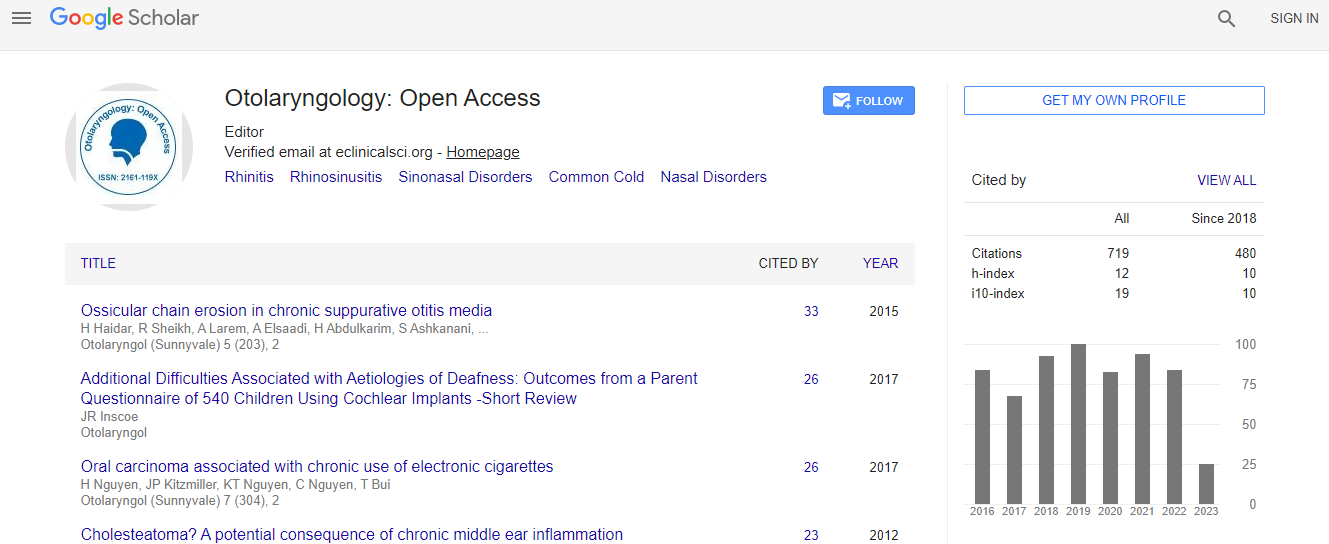Our Group organises 3000+ Global Conferenceseries Events every year across USA, Europe & Asia with support from 1000 more scientific Societies and Publishes 700+ Open Access Journals which contains over 50000 eminent personalities, reputed scientists as editorial board members.
Open Access Journals gaining more Readers and Citations
700 Journals and 15,000,000 Readers Each Journal is getting 25,000+ Readers
Google Scholar citation report
Citations : 925
Otolaryngology: Open Access received 925 citations as per Google Scholar report
Otolaryngology: Open Access peer review process verified at publons
Indexed In
- Index Copernicus
- Google Scholar
- Sherpa Romeo
- Open J Gate
- Genamics JournalSeek
- RefSeek
- Hamdard University
- EBSCO A-Z
- OCLC- WorldCat
- Publons
- Geneva Foundation for Medical Education and Research
- ICMJE
Useful Links
Recommended Journals
Related Subjects
Share This Page
Otic and nasal structures in brain cooling system
3rd International Conference and Exhibition on Rhinology & Otology
M Kemal Irmak
Gulhane Military Medical Academy, Turkey
ScientificTracks Abstracts: Otolaryngology
Abstract
Brain is protected from thermal damage by a so-called radiator system: brain cooling system. As brain gets hotter, the veins of this radiator system bring in cool blood from the evaporating surfaces of skin and craniofacial cavities. Nasal cavity, paranasal sinuses, tympanic cavity and certain parts of head, skin are the major components of this system. The cooling occurs through evaporation of mucus or sweat, and the transfer of the cool venous blood to the brain. Therefore washing or wetting these surfaces of the head (face, mouth, nose, scalp, nape and ears) a number of times help the brain to remain cool throughout the day. In hot climates as in Africa, craniofacial features such as thick everted lips, broader nasal cavity and bigger paranasal sinuses provide more evaporating surfaces for an effective brain cooling. These geographic variations are due to direct environmental effects which, over many generations, became inherited. Epigenetic inheritance system is a genetic regulatory mechanism that allows humans to maintain extraordinarily stable patterns of gene expression over many generations. It enables organisms to acquire and transmit different phenotypes to the next generation. In this system, heritable changes occur in gene expression that is not encoded in the DNA sequence itself in the germ cells (oocytes). Epigenetic modifications of DNA include covalent modifications of bases in the DNA and of amino acid residues in the histones. But inheritance of adaptive changes is limited to embryonic neural crest derivatives such as craniofacial tissues and melanocytes, and species-to-species evolution seems unlikely.Biography
M Kemal Irmak (MD, PhD) is a Professor of Histology and Embryology in School of Medicine at Gulhane Military Medical Academy (Ankara, Turkey) where he became a medical doctor in 1987. He specialized in Histology and Embryology at Hacettepe University (Ankara) in 1992 and then received a PhD on Biochemistry at Inonu University (Malatya) in 2001. His research is focused on biological adaptation through epigenetic inheritance system and on Merkel cells as electromagnetic receptor cells. He is the author of over 80 papers with over 1300 citations and 16 H-index.
Email: mkirmak@gata.edu.tr

 Spanish
Spanish  Chinese
Chinese  Russian
Russian  German
German  French
French  Japanese
Japanese  Portuguese
Portuguese  Hindi
Hindi 
